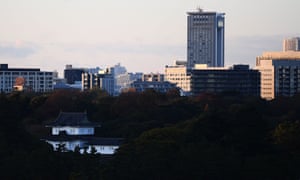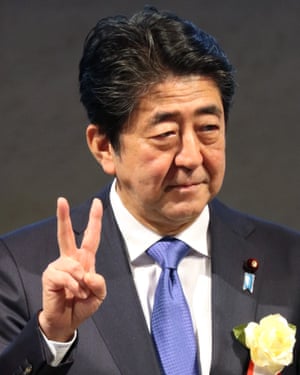Home » World News »
How Japan has fared in 30 years since the stock market bubble burst
On 29 December 1989, Japan’s Nikkei stock market index hit a high of 38,916, a milestone that proved to be the last hurrah of the country’s asset-inflated bubble economy – a period of ostentatious consumption and overconfidence in the infallibility of Japan, Inc.
What followed was a spectacular fall from the heights of the mid- to late 1980s. The stock market plummeted, losing more than $2tn (£1.5tn) in value by December 1990. In the years that followed, the Japanese surveyed an alien landscape of “restructuring” – code for cost-cutting – deflation and stagnation. When the bubble party ended, its hosts appeared to have no idea how to clean up the mess left by absurdly high share and property prices.
Occasional outbreaks of nostalgia for the excesses of the boom years, when the ground beneath the imperial palace was said to be worth more than the entire state of California, have become a coping mechanism for a country now facing a new set of economic problems.
“Japan’s 1980s bubble was the bursting start of a long adaption from a young, fast-growing economy to an ageing, slow-growth new normal,” says Martin Schulz, senior economist at the Fujitsu Research Institute.
“It took until 2002 to bail out the banks from the real estate adjustment. It took another 10 years to put the necessary supply-side and social security reforms in place. The benign impact of the global financial crisis has shown that Japan’s economy has fully adjusted to its ‘new normal’ of slow but solid long-term growth.”
Schulz adds that the economic policies of the current prime minister, Shinzo Abe, have done some good for a nation that remains a global powerhouse as the world’s third-largest economy.
“Abenomics is working to get innovation going again and to improve future expectations. Japan is now much better integrated in Asia with its long-term growth prospects. Its service economy is flourishing again and embraces digitalisation, people find jobs well into retirement, and the young generation is optimistic. What’s missing are better work-life balances to enable families to have children again, and a more proactive stance to deal with the long-term debt overhang.”
The end of the bubble era coincided with the enthronement of a new emperor. While Akihito sought to bring the imperial family closer to ordinary people, much of his three decades on the Chrysanthemum throne, which ended with his abdication this April, was marked by policy drift and a creeping fear that Japan’s post-bubble woes were merely the precursor to long-term decline.
Enter Abe, hawkish on defence and conservative on social issues, but wedded to Keynesian notions of the state as a benign spending force for economic good. “Japan is back,” he declared when he became prime minister for the second time in late 2012.
It wasn’t long before optimism over Abenomics, at home and abroad, began to chip away at the “lost decades” narrative that followed the bubble era. The first two of Abe’s “three arrows” – fiscal stimulus in the form of infrastructure spending, and loose monetary policy from the Bank of Japan, in the form of 0% interest rates and buying bonds off financial inistitutions in a process known as quantitative easing – had the desired effect. The Nikkei began to rise – though, at about 24,000 points, it is currently far from the levels of 30 years ago – and export-dependent manufacturers cheered a weaker yen.
But after seven years of Abe, who recently became Japan’s longest-serving prime minister, a more mixed picture is emerging. There are more jobs than people to fill them and record numbers of tourists, mainly from other parts of Asia, are bringing a glimmer of hope to depopulated regions.
But there have been policy failures that highlight the perils of vowing to nudge Japan out of its deflationary, low-growth orbit.
Abe’s attempt to achieve 2% inflation came up short – the CPI rate is running at 0.5% – and questions persist over corporate governance in the wake of the allegations against the former Nissan chairman Carlos Ghosn.
Growth in the Japanese economy was 0.4% in the third quarter of this year. But there are fears that soft global demand and the US-China trade war will hit exports.
There is concern, too, that a recent rise in the consumption (sales) tax, from 8% to 10%, to address Japan’s public debt burden – the highest in the industrial world and more than twice the size of its $5tn economy – will weaken private consumption.
Japanese economy posts longest expansion in more than a decade
Abe’s first two arrows are still in flight, with the government announcing a record budget this month that its architect hopes will buy his economic project time and win him support after a series of damaging political scandals.
It includes 13.2tn yen ($121bn) in public spending on disaster reconstruction, infrastructure and scientific research designed to shield the economy from a possible slowdown caused by a US-Japan trade war and a post-2020 Olympic hangover.
But critics say the third and most critical part of his programme, structural reform, looks more like a badly thrown dart than an arrow, despite grim warnings about the failure to address the effects on long-term growth of a super-ageing, declining population.
Abe has encouraged more women to enter the workforce and relaxed immigration laws to allow a modest number of blue-collar workers to fill gaps in pressurised sectors of the economy. But much needed reform of the labour market, corporate governance and healthcare have been slow to materialise.
“Monetary easing and fiscal stimulus were supposed to make room for structural reform,” says Koichi Nakano, a politics professor at Sophia University in Tokyo. “But structural reform hasn’t happened. This means the Japanese economy continues to depend on government steroids. God knows what will happen after the Olympics.
“Abe’s economic policy gave him enough political capital to push through much of his rightwing agenda – like the state secrets law and security legislation – but the government can’t continue to pump money into the economy, and the Bank of Japan can’t continue to subsidise Japan, Inc. It is telling that he never achieved his inflation target. The fundamental weaknesses of the Japanese economy have never been properly addressed.”
Source: Read Full Article




